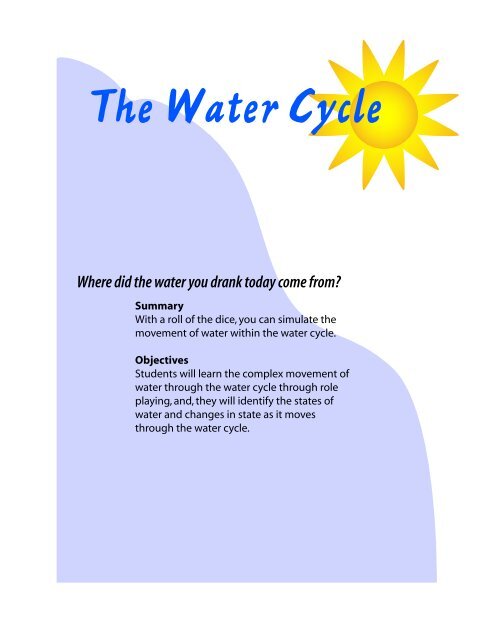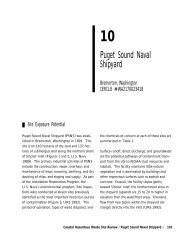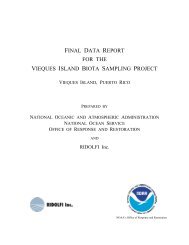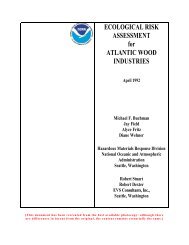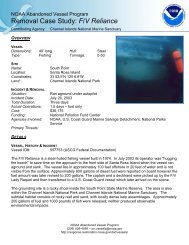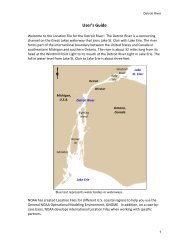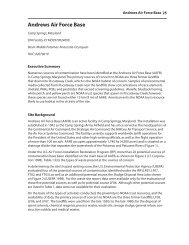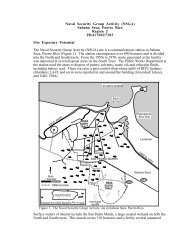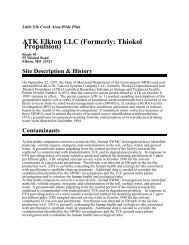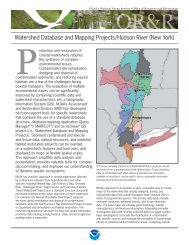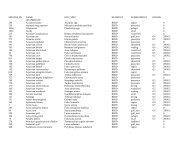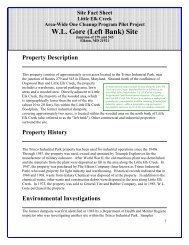Water Cycle Game - Instructions
Water Cycle Game - Instructions
Water Cycle Game - Instructions
- No tags were found...
You also want an ePaper? Increase the reach of your titles
YUMPU automatically turns print PDFs into web optimized ePapers that Google loves.
The <strong>Water</strong> <strong>Cycle</strong>Where did the water you drank today come from?SummaryWith a roll of the dice, you can simulate themovement of water within the water cycle.ObjectivesStudents will learn the complex movement ofwater through the water cycle through roleplaying, and, they will identify the states ofwater and changes in state as it movesthrough the water cycle.
The impact of gravity on the water cycle is viewed elsewhere as well. Liquid watercertainly conforms to the laws of gravity as it flows. But even ice on mountaintopsobeys the laws of gravity as glaciers slowly move downward.The following role-playing game allows you to better understand thecomplexity of the actual water cycle. Stations are set-up for each of ninedifferent compartments of the water cycle. A roll of the die at each stationtells you where to move next or to stay. This game is meant to be playedwith a group of people, so that the path each player takes can becompared with everyone else’s. (It can be done over and over by oneperson to achieve the same results though. Adjust the following instructionsaccordingly.) Trackers – either colored beads or strips of paper areused to track each person’s journey through the water cycle.Materials• Nine special cubes or die with movement instructions (download and print this file)• Nine station illustrations or signs (download and print this file)• A timer• Any noisemaker, such as a bell or whistle• Nine different colors of beads or paper strips (other than black)Preassessment• Explain to the students that they will be tiny bits of water (molecules) in the water cycle. Havethem then list all the places where water can be found in the water cycle. Compare their list to thenine compartments.• Before handing out the instruction die to each station, ask the students at each station to listwhere they think water might go next from their station. Have them compare their list against theinstruction die.• Introduce the concept that water may not go anywhere from a station for some time. Also, havestudents list what forms of water (i.e., states)—liquid, solid, or gas—might be involved in possiblemoves from their stattion.<strong>Instructions</strong>1 Set up stations for the nine die. Place colored beads or paper strips (the trackers) in the die, with onlyone color in each die.2 Randomly assign people evenly among the stations. If there is an odd number, assign the odd personto the ocean.3 To start, each person collects a tracker from their first station, and then rolls the dice. Allow enoughtime for everyone at a station to roll.4 At the sound of the signal, each person then follows the movement instructions from their dice roll andmoves to that station. At the new station, they collect a tracker there and then roll the dice at thatstation. If their instructions were to stay, they should collect another tracker and then roll the dice witheveryone that just moved to that station during the turn.5 Sound the signal at even intervals (the amount of time depends on how many people play) to designateeach turn of play. At each turn, players move; collect a tracker from their new station; and then rollfor new movement instructions for the next turn.6 After a pre-set number of turns (at least 9), compare the trackers from one player to the next. Observethe differences. Notice how long a player might have stayed in one station
Assessment• Have students identify the various compartments of the water cycle, andthe states in which water may be found.• Have students describe where in the water cycle changes of stateoccur.• Have students write an essay describing the water cycle and howwater can take different paths through the cycle or they can use theirown trackers to write creative story about the places water mightvisit in its movements.Contamination ConnectionAlthough many contaminants are hydrophobic (i.e., they tend to sorb ontoparticles), the water cycle plays a very influential role in determining the transport ofcontaminants. The game can be played with an extension to illustrate how water quality is altered as watermoves about. In this version, students collect or remove pollution (black trackers) as they move amongcompartments according to the chart below:If a studentmoves from to Action:Clouds All Collect 1 as airborne contaminants are sorbedAnimal Soil Collect 2 for wastesAnimal Clouds Remove all as water is purified as it is respiredSoil Plants Remove 1 as some plants absorb pollutantsSoil River Collect 2 as runoff carries pollutantsSoil Groundwater Remove 1 as soil filters some pollutantsSoil Clouds Remove all as water is purified as it evaporatesPlants Animals Collect 1 as contaminants are ingestedPlants Clouds Remove all as water is purified as it transpiresOcean Clouds Remove all as water is purified as it evaporatesLake Clouds Remove all as water is purified as it evaporatesLake Groundwater Remove 1 as soil filters some pollutantsLake Animal Collect 1 as contaminants are ingestedLake River Collect 1 as water moves downstreamGlacier Groundwater Remove 1 as soil filters some pollutantsGlacier River Collect 1 as runoff carries pollutantsGlacier Clouds Remove all as water is purified as it sublimatesGroundwater Lake or River Remove 1 as soil filters some pollutantsRiver Groundwater Remove 1 as soil filters some pollutantsRiver Lake or Ocean Collect 1 as water travels downstreamRiver Clouds Remove all as water is purified as it evaporatesRiver Animal Collect 1 as contaminants are ingestedIf a student stays in Lake, River, or Ocean, collect one tracker as pollution is discharged into these waterbodies. For any other moves, students retain the black pollution trackers they already have. Studentscollect trackers at the end of a turn of play when they arrive at their new station or have stayed where theyare. If they are removing trackers, they leave them at their station before they move.
For this extension, place containers with an equal number of black trackers atall stations except Animals and Plants. Place an empty container at the Plantand Animal stations. At the end of play, compare the number of pollutiontrackers each student has, plus the number left in containers at eachstation against the original number.For assessment, students can compare and contrast the effects thatmovement among different water compartments has on water quality.Extensions• To add an art element to this exercise, students can illustrate the stationlabels for the nine stations.• Have students explain how energy from the sun, gravity, geology, andgravity can affect the movement of water from various compartments. Forinstance, solar energy drives greater evaporation from the Red Sea than from the Bering Sea.• Have students identify whenever they need to change state to accomplish their instructed moves fromone compartment to another. Have them track how many state changes they go through.• Have students compare the movement of water during different seasons and at different locationsaround the globe. Have them suggest how the instruction die might be altered to better match conditionsfor a particular location and season.• To simulate the influence of heat on the movement of water, introduce the following addition afterseveral turns of play: have students stop where they are and ask them what would happen to water attheir station if it were hotter (generally, molecules move faster) or colder (molecules move slower). Havethem proceed with the game pretending that the water they represent is now hot (not boiling). Do thesame for water that is nearly frozen. You can even make distinctions for warm- and cold-bloodedanimals.• To illustrate how events can alter water quality, introduce pollution scenarios partway through thegame. For instance, have the students stop where they are and then read them a scenario card you havewritten. For example, an oil spill occurs. Or, a neighbor changes the oil in his car and dumps the used oildown the drain during a rain storm which then washes into a river. Several extra pollution trackerswould be collected in the appropriate stations under these situations.• For a math extension, explain to students they are assigned equally among stations to keep the exerciseflowing and to better illustrate the water cycle. However, if they were assigned to stations according tohow much water should be there, the numbers would not be even. Have them calculate how manystudents should be assigned to each compartment if that figure were proportional to the amount ofwater actually in that compartment. Use the following figures:Oceans – 79% Lakes and rivers – 0.002%Soil and Ground water – 18.8% Atmosphere – 0.0006%Ice – 1.2%Vocabulary and Concepts UsedEvaporationSublimationPercolationStates of matterPrecipitationTranspirationGround waterEffects of heat upon water movementReferences and ResourcesSome of this material has been adapted from the Project WET Curriculum and Activity Guide, 1995, Bozeman,MT.Garrels, R.M. et al. 1975. Chemical <strong>Cycle</strong>s in the Global Environment. William Kaufmann, Inc. 206 pp.


